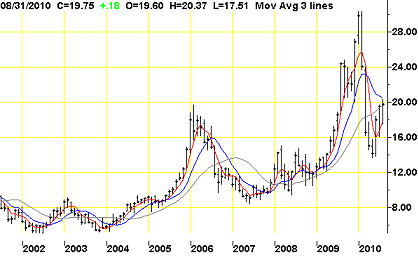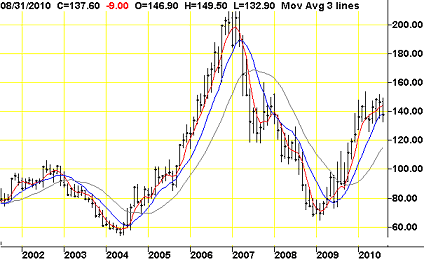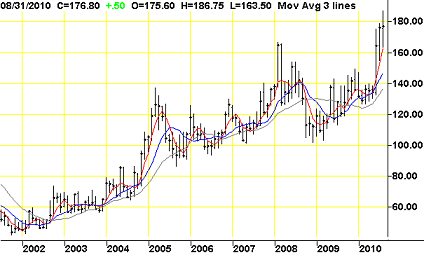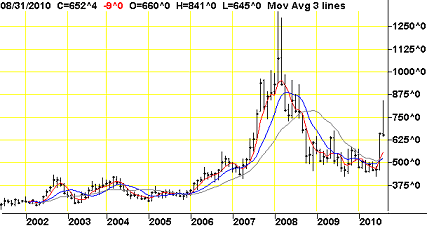-
I’m not worried about gasoline
prices -
The price of everything is going to
skyrocket -
How to buy agriculture with one
investment
I’ve talked at length about the direct connection between
oil and oil prices and just about every good, service and commodity that can
be bought, sold or stolen.
For some industries – like shipping – oil prices are one of
the biggest cost inputs. Other industries, like…oh say, online publishing,
are somewhat less dependent on oil.
But every sector of the economy does have an oil cost
input.
That’s why I’m extremely worried about oil prices, and where
we all know they’re going.
For a small taste of what’s in store, Charles Maxwell, senior energy analyst
for Weeden & Co. – a man with 50 years experience in the field – recently
predicted that we’ll see $150/barrel oil within the next five years, and $300
oil by 2020.
I’m a bit less optimistic – because I think we could easily
break the $150 barrier in the next 18 months. It was only 24 months ago that
we saw similar prices – so it’s not out of the question.
Being that I’m not
in a field that relies on very much oil consumption, I’m not too terribly
worried about my gasoline costs. My wife and I currently spend an average of
$271 a month on gasoline. We know the exact average because we use a pretty
nifty (and free) financial service available at http://www.mint.com.
It breaks down our expenses, income and debt into very tidy
metrics. We have it set so that we get text messages to our cell phones when
we’re approaching budget limits on eating out at restaurants, account
minimums, or when an important bill is coming due. I don’t have any incentive
to tell you this, but I highly recommend Mint if you’re looking for a very
sharp personal finance tool.
In any event, that $271 is a pretty reliable average number
for us right now.
Even if that number doubles or triples, it’ll sting a
little, but it won’t break the bank by any means. And my wife and I can
mitigate that cost pretty easily by carpooling more often, or working from
home every now and then.
So what exactly, am I worried about?
Well, like many of you, I worry that I might not be able to
accumulate enough shares of the appropriate companies in the appropriate
sectors between now and when the oil hits the fan.
That’s the thin end
of the wedge however. I also worry that current prices for everything we
consume right now represent a coiled spring, and that higher oil prices will
be a catalyst for higher everything-prices.
This morning I went through and looked at spot price charts
for the major commodities that I consume on a daily basis – like coffee,
milk, wheat, corn, orange juice, pork, beef, rice – and everything is on the
rise.
As energy analyst Gregor Macdonald of Energy
World Profits recently reminded me, all commodity price
action is in some way affected by speculators in the short term, but I’m not
looking at the short term.
Yes, prices for most commodities are up this year – mostly
from movement in the past few months – but I’m looking at average prices over
the past ten years at least.
Here are some ten year charts of the most prevalent
commodities – the stuff that you and I consume on a daily basis:
Sugar: up 150%:
Orange juice: up 82%
Coffee: up 193%
Wheat: up 407%
And one last chart, showing oil prices.
Oil is up 150% over the past 10 years, although it went much
higher, as you might remember.
And looking at the commodity charts above, you can see that
some are more tightly correlated with oil prices than others. But in the past
year, oil has traded flat, in a range between $70 and $85 a barrel.
The writing is literally on the wall:
When (not if) oil prices rise, we’re looking at
much higher prices for nearly every commodity.
You and I can cut back on gasoline if we have to – but what
about sugar, corn, wheat and (heaven forbid) coffee?
I’m pretty happy with my level of consumption of these
commodities, and I don’t plan on cutting back.
Theinvestment
implications are clear: buy shares of oil companies when they’re cheap – but
more importantly, begin a stockpile of agriculture stocks, as well as
physical goods.
The good news is that a great buying opportunity for ag
stocks may be on the horizon. Everyone’s favorite bank, Goldman Sachs
(NYSE: GS), recently released an analyst report on commodities. In
it, they predict that agriculture prices will drop 10% in the next 12
months.
So my advice would be to look for opportunities in the
agriculture sector in the next year – and average into your favorite
positions during dips.
If you’re looking for an agriculture ETF you should check
out a recent write-up that I completed. I worked closely with Ian Wyatt to
produce a special report on our three favorite ETFs. One of them is an
agriculture ETF that holds every major ag producer. You can buy them all in
one fell swoop.
Click
here for the full story.
Good investing,
Kevin McElroy
Editor
Resource Prospector
 Facebook
Facebook
 Twitter
Twitter




